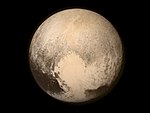astro.wikisort.org - Meteorite
K2-3c also known as EPIC 201367065 c is an exoplanet orbiting K2-3 a red dwarf every 24 days. It is 144 ly away.[4] It has a density of 1.82g/cm3, indicating that it could be a Gas dwarf or a mini-Neptune. It is one of the smallest gas planets ever discovered. Despite not being the smallest planet in the system by radius,[5] by mass it is by far the least massive, with a mass only double that of Earth.[5]
| Discovery[1] | |
|---|---|
| Discovery site | Kepler Space Observatory |
| Discovery date | 2015 |
Detection method | Transit |
| Orbital characteristics | |
Semi-major axis | 0.1413+0.0044 −0.0047 AU |
| Eccentricity | 0.04±0.04[2] |
Orbital period (sidereal) | 24.64638±0.00017[3] d |
| Inclination | 89.70±0.20[2] |
| Semi-amplitude | 0.95±0.37[3] |
| Star | K2-3 |
| Physical characteristics | |
Mean radius | 1.77±0.18[3] REarth |
| Mass | 3.1+1.3 −1.2[3] MEarth |
Mean density | 3.1+1.9 −1.3 g cm−3 |
| Temperature | 374 K (101 °C; 214 °F) |
References
- Crossfield, Ian J. M.; et al. (2015). "A Nearby M Star with Three Transiting Super-Earths Discovered by K2". The Astrophysical Journal. 804 (1). 10. arXiv:1501.03798. Bibcode:2015ApJ...804...10C. doi:10.1088/0004-637X/804/1/10.
- "K2-3 c CONFIRMED PLANET OVERVIEW PAGE". NASA Exoplanet Archive. Retrieved 2015-10-17.
- Damasso, Mario; et al. (2018). "Eyes on K2-3: A system of three likely sub-Neptunes characterized with HARPS-N and HARPS". Astronomy and Astrophysics. 615. A69. arXiv:1802.08320. Bibcode:2018A&A...615A..69D. doi:10.1051/0004-6361/201732459. S2CID 58923147.
- Brown, A. G. A.; et al. (Gaia collaboration) (August 2018). "Gaia Data Release 2: Summary of the contents and survey properties". Astronomy & Astrophysics. 616. A1. arXiv:1804.09365. Bibcode:2018A&A...616A...1G. doi:10.1051/0004-6361/201833051. Gaia DR2 record for this source at VizieR.
- "K2-3 PLANET HOST PAGE". NASA Exoplanet Archive. Retrieved 2015-10-17.
Текст в блоке "Читать" взят с сайта "Википедия" и доступен по лицензии Creative Commons Attribution-ShareAlike; в отдельных случаях могут действовать дополнительные условия.
Другой контент может иметь иную лицензию. Перед использованием материалов сайта WikiSort.org внимательно изучите правила лицензирования конкретных элементов наполнения сайта.
Другой контент может иметь иную лицензию. Перед использованием материалов сайта WikiSort.org внимательно изучите правила лицензирования конкретных элементов наполнения сайта.
2019-2025
WikiSort.org - проект по пересортировке и дополнению контента Википедии
WikiSort.org - проект по пересортировке и дополнению контента Википедии


